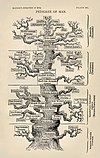Portal:Paleontology
|
The Palaeontology Portal
Introduction Paleontology (/ˌpeɪliɒnˈtɒlədʒi, ˌpæli-, -ən-/ PAY-lee-on-TOL-ə-jee, PAL-ee-, -ən-), also spelled palaeontology or palæontology, is the scientific study of life that existed prior to the start of the Holocene epoch (roughly 11,700 years before present). It includes the study of fossils to classify organisms and study their interactions with each other and their environments (their paleoecology). Paleontological observations have been documented as far back as the 5th century BC. The science became established in the 18th century as a result of Georges Cuvier's work on comparative anatomy, and developed rapidly in the 19th century. The term has been used since 1822 formed from Greek παλαιός ('palaios', "old, ancient"), ὄν ('on', (gen. 'ontos'), "being, creature"), and λόγος ('logos', "speech, thought, study"). Paleontology lies on the border between biology and geology, but it differs from archaeology in that it excludes the study of anatomically modern humans. It now uses techniques drawn from a wide range of sciences, including biochemistry, mathematics, and engineering. Use of all these techniques has enabled paleontologists to discover much of the evolutionary history of life, almost back to when Earth became capable of supporting life, nearly 4 billion years ago. As knowledge has increased, paleontology has developed specialised sub-divisions, some of which focus on different types of fossil organisms while others study ecology and environmental history, such as ancient climates. (Full article...) Selected article on the prehistoric world and its legacies
Waptia fieldensis is an extinct species of arthropod from the Middle Cambrian Burgess Shale Lagerstätte of Canada. It grew to a length of about8 cm (3 in) and resembled modern shrimp in both morphology and habit. It had a large bivalved carapace and a segmented body terminating into a pair of tail flaps. It was an active swimmer, feeding on organic particles it gathers from the seafloor substrate.
Based on the number of individuals, Waptia fieldensis is the third most abundant arthropod from the Burgess Shale Formation, with thousands of specimens collected. It was among the first fossils found by the American paleontologist Charles D. Walcott in 1909. He described it in 1912 and named it after two mountains near the discovery site – Wapta Mountain and Mount Field. Waptia fieldensis is the only species classified under the genus Waptia. Although it bears a remarkable resemblance to modern crustaceans, its taxonomic affinities remain unclear. It is currently classified as a stem group crustacean and tentatively included in the clade Crustaceomorpha. (see more...) Did you know?

General images -The following are images from various paleontology-related articles on Wikipedia.
Selected article on paleontology in human science, culture and economics In 1858, Charles Darwin and Alfred Russel Wallace published a new evolutionary theory that was explained in detail in Darwin's On the Origin of Species (1859). Unlike Lamarck, Darwin proposedcommon descent and a branching tree of life. The theory was based on the idea of natural selection, and it synthesized a broad range of evidence from animal husbandry, biogeography, geology, morphology, and embryology. The debate over Darwin's work led to the rapid acceptance of the general concept of evolution, but the specific mechanism he proposed, natural selection, was not widely accepted until it was revived by developments in biology that occurred during the 1920s through the 1940s. Before that time most biologists argued that other factors were responsible for evolution. The synthesis of natural selection with Mendelian genetics during the 1920s and 1930s founded the new discipline of population genetics. Throughout the 1930s and 1940s, population genetics became integrated with other biological fields, resulting in a widely applicable theory of evolution that encompassed much of biology—the modern evolutionary synthesis. (see more...) On this day...May 28:
Feeding Mechanics in Spinosaurid Theropods and Extant Crocodilians Andrew R. Cuff, Emily J. Rayfield published 28 May 2013 Selected image
CategoriesTopicsGeneral - Paleontology - Fossil - Evolution - Extinction Quality ContentFeatured paleontology articles
- Achelousaurus
- Acrocanthosaurus
- Albertosaurus
- Allosaurus
- Amargasaurus
- Ankylosaurus
- Apatosaurus
- Archaeopteryx
- Baryonyx
- Carnotaurus
- Catopsbaatar
- Ceratosaurus
- Chicxulub Crater
- Compsognathus
- Cretaceous–Tertiary extinction event
- Daspletosaurus
- Deinocheirus
- Deinonychus
- Deinosuchus
- Dilophosaurus
- Dinosaur
- Diplodocus
- Dromaeosauroides
- Edmontosaurus
- Elasmosaurus
- Giganotosaurus
- Gorgosaurus
- Herrerasaurus
- Iguanodon
- Istiodactylus
- Lambeosaurus
- List of dinosaur genera
- Majungasaurus
- Massospondylus
- Megalodon
- Nemegtomaia
- Nigersaurus
- Opisthocoelicaudia
- Paranthodon
- Parasaurolophus
- Plateosaurus
- Psittacosaurus
- Seorsumuscardinus
- Spinosaurus
- Stegosaurus
- Stegoceras
- Styracosaurus
- Tarbosaurus
- Thescelosaurus
- Triceratops
- Tyrannosaurus
- Velociraptor
Things you can doCurrent Paleontology FACs - None yet... WikiProjectsRelated portalsAssociated WikimediaThe following Wikimedia Foundation sister projects provide more on this subject:
Discover Wikipedia using portals |








































